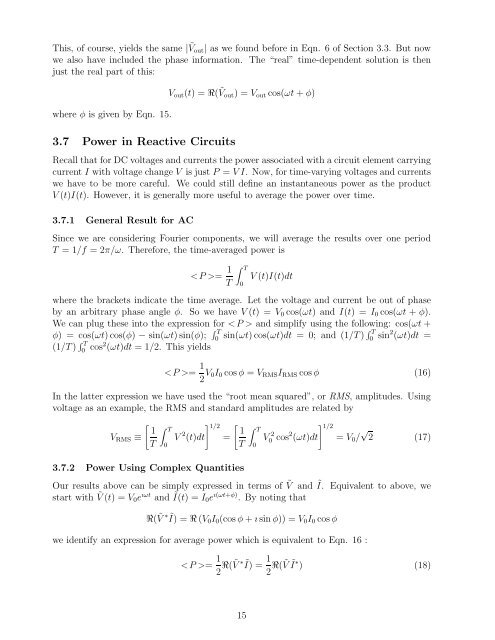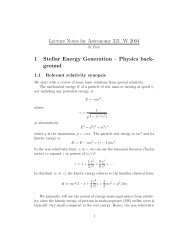Lecture Notes for Analog Electronics - The Electronic Universe ...
Lecture Notes for Analog Electronics - The Electronic Universe ...
Lecture Notes for Analog Electronics - The Electronic Universe ...
You also want an ePaper? Increase the reach of your titles
YUMPU automatically turns print PDFs into web optimized ePapers that Google loves.
This, of course, yields the same | ˜ Vout| as we found be<strong>for</strong>e in Eqn. 6 of Section 3.3. But now<br />
we also have included the phase in<strong>for</strong>mation. <strong>The</strong> “real” time-dependent solution is then<br />
just the real part of this:<br />
where φ is given by Eqn. 15.<br />
3.7 Power in Reactive Circuits<br />
Vout(t) =ℜ( ˜ Vout) =Vout cos(ωt + φ)<br />
Recall that <strong>for</strong> DC voltages and currents the power associated with a circuit element carrying<br />
current I with voltage change V is just P = VI. Now, <strong>for</strong> time-varying voltages and currents<br />
we have to be more careful. We could still define an instantaneous power as the product<br />
V (t)I(t). However, it is generally more useful to average the power over time.<br />
3.7.1 General Result <strong>for</strong> AC<br />
Since we are considering Fourier components, we will average the results over one period<br />
T =1/f =2π/ω. <strong>The</strong>re<strong>for</strong>e, the time-averaged power is<br />
� T<br />
= 1<br />
V(t)I(t)dt<br />
T 0<br />
where the brackets indicate the time average. Let the voltage and current be out of phase<br />
by an arbitrary phase angle φ. So we have V(t)=V0cos(ωt) andI(t)=I0cos(ωt + φ).<br />
We can plug these into the expression <strong>for</strong> and simplify using the following: cos(ωt +<br />
φ) =cos(ωt)cos(φ) − sin(ωt)sin(φ); � T<br />
0 sin(ωt)cos(ωt)dt =0;and(1/T ) � T<br />
0 sin2 (ωt)dt =<br />
(1/T ) � T<br />
0 cos2 (ωt)dt =1/2. This yields<br />
= 1<br />
2 V0I0cos φ = VRMSIRMS cos φ (16)<br />
In the latter expression we have used the “root mean squared”, or RMS, amplitudes. Using<br />
voltage as an example, the RMS and standard amplitudes are related by<br />
VRMS ≡<br />
� 1<br />
T<br />
� T<br />
0<br />
V 2 (t)dt<br />
� 1/2<br />
=<br />
� 1<br />
T<br />
3.7.2 Power Using Complex Quantities<br />
� T<br />
0<br />
V 2<br />
0 cos2 �1/2 (ωt)dt<br />
Our results above can be simply expressed in terms of ˜ V and<br />
start with ˜ V (t) =V0e ıωt and Ĩ(t) =I0e ı(ωt+φ) .Bynotingthat<br />
ℜ( ˜ V ∗ Ĩ)=ℜ(V0I0(cos φ + ı sin φ)) = V0I0 cos φ<br />
we identify an expression <strong>for</strong> average power which is equivalent to Eqn. 16 :<br />
= V0/ √ 2 (17)<br />
Ĩ. Equivalent to above, we<br />
= 1<br />
2 ℜ(˜ V ∗ Ĩ)= 1<br />
2 ℜ(˜ V Ĩ∗ ) (18)<br />
15













